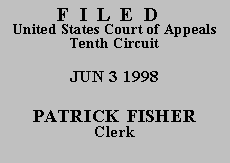

| UNITED STATES OF AMERICA, |
No. 97-6120 |
| v. |
W.D. Oklahoma |
| TAYOUN LEESHAW BELL, |
(D.C. No. CR-96-84-T) |
Tayoun Leeshawn Bell pleaded guilty to possession with intent to distribute approximately nine ounces of cocaine base, in violation of 21 U.S.C. § 841(a)(1). He now appeals the sentence imposed, contending that the district court erred (1) by refusing to decrease his offense level based on his minor role as provided in U.S.S.G. § 3B1.2, and (2) by increasing his offense level for possession of a weapon pursuant to U.S.S.G. § 2D1.1(b)(1). We affirm.
Respecting his first claim of error, Bell contends that the district court improperly relied on hearsay evidence when it determined he was not entitled to a downward adjustment based on his role in the offense. He also contends that there was no evidence placing him in Oklahoma City during the relevant times.
We review a trial court's findings concerning a defendant's role in a particular offense for clear error. United States v. Santistevan, 39 F.3d 250, 253 (10th Cir. 1994). A finding of fact is clearly erroneous if it is without support in the record. Id. However, a sentencing court's factual findings may be supported by hearsay statements as long as the statements possess some "minimal indicia of reliability," United States v. Browning, 61 F.3d 752, 755 (10th Cir. 1995), and the defendant bears the burden of establishing, by a preponderance of the evidence, his entitlement to an offense level reduction under § 3B1.2. Santistevan, 39 F.3d at 253.
In this case, Bell presented no evidence to support his claim that his role was only minor. At the sentencing hearing, the investigating detective testified regarding information he had received from three lower-level distributors and participants who either witnessed transactions or obtained substantial amounts of crack cocaine from Bell. Although the detective's testimony at the sentencing hearing was more detailed on this issue, the three interviewed persons had previously testified at a related trial over which the sentencing judge had presided, and their court testimony was consistent with their statements to the detective. The detective's testimony summarizing his interviews, together with the witnesses' testimony at the related trial and Bell's own admissions to the parole officer writing the Presentence Investigation Report ("PSR"), is sufficiently reliable to establish that Bell was more than a minor participant in the drug distribution ring. See R. Vol. II at 18-21 (containing the detective's testimony at the sentencing hearing which summarized his interviews with various witnesses); see also PSR, R. Vol. IV ¶¶ 19-20 (setting forth Bell's admitted participation in five trips and related transactions involving the transportation and distribution of a total of 35½ ounces of crack cocaine); related Case No. 97-6167, R. Vol. III at 85-86, 105, 115 (setting forth the witnesses' trial testimony regarding Bell's role). Accordingly, the district court did not err in refusing to decrease Bell's offense level pursuant to U.S.S.G. § 3B1.2.
As his second claim of error, Bell complains that there was no evidence linking him to any weapon, and there was no evidence linking any weapon to any drug offense. Guideline § 2D1.1(b)(1) requires a two level increase in the offense level if a dangerous weapon "was possessed." The accompanying commentary provides that "[t]he adjustment should be applied if the weapon was present, unless it is clearly improbable that the weapon was connected with the offense." Id., comment. (n.3). We have previously held that the government initially bears the burden of establishing, by a preponderance of the evidence, the temporal and physical proximity of the weapon to the drug offense. See United States v. Lang, 81 F.3d 955, 964 (10th Cir. 1996). This burden may be satisfied by evidence showing that the weapon was in the same general location where drugs were stored or where the drug transactions occurred. Once the government meets its burden of showing proximity, the burden shifts to the defendant to show that the enhancement should not apply because it is "clearly improbable" the weapon was connected with the offense. Id. The district court's ruling that a § 2D1.1(b)(1) enhancement is applicable is a finding of fact that we review for clear error. United States v. Underwood, 938 F.2d 1086, 1091 (10th Cir. 1991).
At the sentencing hearing, the investigating detective recounted the information he had received from Burgundy Pierce, a witness who had been present during several drug transactions involving Bell. According to Pierce's statements, Bell would routinely obtain a 9mm semiautomatic pistol whenever he arrived in Oklahoma City with drugs. Pierce also advised the detective that Bell kept a rifle at her home along with a quantity of cocaine, and this information was further corroborated in the detective's interviews with another drug distributor, Ahmad Davis. See R. Vol. II at 10-11, 14-15. Additionally, at a related trial, Pierce testified that Bell had a gun in the apartment where drugs were distributed and also had a shotgun or rifle which he kept at her house. See Case No. 97-6167, R. Vol. III at 82-83. Bell presented no opposing evidence, but simply argued that the evidence presented was insufficient to support the enhancement. We disagree. The district court did not err in finding that a § 2D1.1(b)(1) offense level increase applied.
AFFIRMED.
ENTERED FOR THE COURT
Stephen H. Anderson
Circuit Judge
*.This order and judgment is not binding precedent, except under the doctrines of law of the case, res judicata, and collateral estoppel. The court generally disfavors the citation of orders and judgments; nevertheless, an order and judgment may be cited under the terms and conditions of 10th Cir. R. 36.3.